#archaeology tube
Text
In honor of hbomberguy's video...
I've found a youtube response to the hbomberguy video that isn't just content hunting/recuts! And doesn't seem to be a planned thing like Todd!
Mostly because this is an academic using the hbomberguy video as a jumping off point to talk to the camera, with few edits, about how to cite your sources.
Don't Be Like James Somerton: Advice on Citations and Plagiarism by Archaeology Tube
This is a very reasonable kind of thing to see a day or two after a big story hits. Not edited in a way that's super intensive, and clearly a lecture--too happy to be a rant, honestly--that the person has locked and loaded and has obviously thought about a lot... presumably because, as an academic, it's kind of super necessary.
5K notes
·
View notes
Text
If you look from above, you can see thousands of stone structures dotting the landscape of the Arabian peninsula. On the ground, you can find a bounty of stone tools and ancient fireplaces scattered along the edges of ancient lakes, as well as rock art depicting hunting and herding scenes in the surrounding mountains.
Despite the visibility of these sites, only in the past decade or so have archaeologists taken a dedicated interest in them. Some of the structures have now been dated at up to 10,000 years old.
However, the arid climate, baking days and freezing nights, and intense wind erosion are not kind to some of the other relics archaeologists prize. To date, there has been little found in the way of fossils or the kind of deeply buried, layered deposits that can open a window onto the history of a place.
Until recently, no archaeologists had surveyed any of the hundreds of caves and lava tubes recorded across northern Arabia. In 2019, our team began to look in these subterranean locations—and in a new study published April 17 in PLoS ONE, we report on the first documented occupation of a lava tube in the Arabian Peninsula.
Continue Reading.
#Science#archaeology#anthropology#anthropologie#Saudi Arabia#Middle East#science#stem#Lava tubes#geology
113 notes
·
View notes
Text


~ Bipartite Kohl Tube.
Date: A.D. 3rd–4th century
Place of origin: Roman Empire
Culture: Roman
Medium: Glass, bronze
#ancient#ancient art#history#museum#archeology#roman#ancient history#archaeology#roman empire#ancient roman#Kohl Tube#3rd century#4th century
718 notes
·
View notes
Text
This is interesting. The fact that the site hasn't changed in 10,000 years is fascinating, I think. Just a continuous line of people doing the same thing for literally millennia.
14 notes
·
View notes
Text
.
#this is the year i get 200 different heath problems i guess#doc is like. hey so u have pots and a hip problem and a mosaic chromosonal disorder and maybe long covid too from that one time you had it#thank goodness when i had another additional health problem they were willing to take my tubes out bc im not bringing a kiddo into the world#not this world and with this body#obligatory mention that im not against other ill or disabled people having kids it's just not something i can handle myself so#not gonna be able to raise someone with the same issues#also i didnt want to experience pregnancy which is reason enough#guess i gotta eat more salt and do PT#im an archaeology intern ya girl has got to be well enough to dig
2 notes
·
View notes
Text
i love aspec people sooo much
#lgbtqia+ soc ran an ace talk series (focused (but not exclusively) on STEM since it's queer people in stem day - i think)#and it was soooo much fun all the talks were VERY interesting#there was a very cool scicomm woman there who gave out some ace flag test tube pins#and who made a STEM is a Spectrum Like Asexuality joke when i joked about archaeology being a fake STEM subject. role model#like. idk i haven't had a great week (with one major exception) so it was nice to just chill out and drink tea and make bad jokes#aroace tag
2 notes
·
View notes
Text
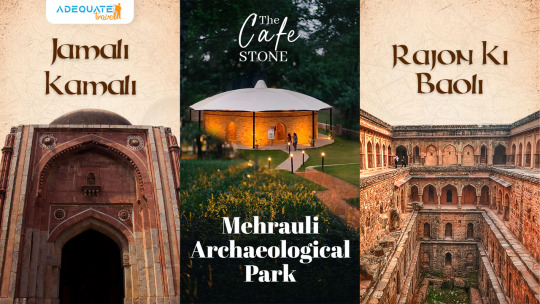
The Mehrauli Archaeological Park is a fascinating historical site located in Mehrauli, Delhi, India. It's spread over an area of about 200 acres and is home to numerous ancient monuments, tombs, mosques, and other structures dating back to the medieval period. The park is a treasure trove for history enthusiasts and provides insights into Delhi's rich cultural and architectural heritage
0 notes
Text
Why is it apparently impossible to buy modern replica faience beads and incredibly easy to buy “mummy beads.”
GOd I just want to make a cool Ancient Egyptian inspired necklace, NOT BE PARTY TO GRAVE ROBBERY AND TRAFFICKING IN ANTIQUITIES!
#if anyone does happen to know a source for turquoise colored faience tube beads I BEG you to hit me up#urggg#archaeology#ancient egypt
1 note
·
View note
Note
(TW for cannibalism, specifically necro cannibalism which is eating dead people)
So, victorians ate mummies (like the kind from Egypt) because it was believed that it was medicinal. Viewing dead bodies as having medicinal properties was a belief dating back to the middle ages, but practiced rather infrequently. However, at the height of the victorian obsession for Egypt (called Egyptomania), along with using mummies to produce an oil paint of the shade mummy brown, they were also eaten as medicine. Something a little less morbid, one guy allegedly found out how his tube of mummy brown paint was produced, and held a little funeral for it. The only reason these practices ended is because they literally ran out of mummies.
(This might become a daily thing, I have way too much to say and not enough people to say it to :( )
YEAH WE TALKED A LOT ABOUT THIS IN MY ANTHRO CLASSES SINCE I WAS ON THE ARCHAEOLOGY TRACK IT'S FUCKING WILD
The BritishTM will never cease to frighten me, also funfact there is a rare parasitic disease that is only so rare BECAUSE YOU CAN ONLY GET IT FROM EATING DEAD BODIES and also British Museums return the stolen artifacts to their home countries they're not yours to display, and I don't care if you're “preserving them” for future generations THOSE WERE NEVER YOURS TO DECIDE THAT RETURN THEM YOU CUNTS
And that goes for American historical museums with Native artifacts, GIVE THEM BACK some of those you straight up just took from Natives' yards and graves you asses
Anyways I have some very strong feelings about the historical museum industry and their workings (also go ahead i also have many thoughts all the time that I like to share)
20 notes
·
View notes
Text
the other day for my archaeology class we had to examine an "artifact" from two different archaeological perspectives. i chose cultural-historical and processual. the artifact in question was a cathode-ray tube (CRT) tv and despite growing up with them almost exclusively until i was in my teen years, i realized that i actually didn't know like. almost anything about how they WORKED. so i went and watched someone explain how to take them apart and about how they worked, and that shit was absolutely fucking fascinating.
anyways i say all this to say i now know why CRTs are so dangerous/delicate and heavy. and i think that in fallout new vegas the securitrons screens should blow up more.
18 notes
·
View notes
Text
found a box of rocks yesterday.
White lie, found it early in October.
OPENed a box of rocks yesterday. Inside was 3 large worked rocks (one bowl shaped and two that looked like pestles to my unpracticed eye) and a small container and then a plastic bag/liner with more rocks.
The container had 90 broken fletched darts (what most people would call arrow heads).
the bag had 323 bits of fletched rock, 1 bone, and 1 partial fossil.
total of 418 bits of First Nation history with absolutely no care taken. No documentation. No indication of respect.
I layed them all out like so



and then rolled the foam up into tubes which I numbered the outside of.
I also subdivided them as much as I could by type (micrblade, fletched darts, fletched disks). It took me 3 hours to get through the box.
They are now in the collecrion "archaeology unknown year" but that's as specific as I can get.
#museums#museum#accessibility#museum spaces#actually autistic#repatriation#first nations#accession#inventory
71 notes
·
View notes
Text
"The egg has been taken to the Natural History Museum in London. Edward Biddulph, the senior project manager at Oxford Archaeology said it had felt a little daunting riding on the tube and walking around the capital with such an extraordinary and fragile egg in his care."
"Dana Goodburn-Brown, an archaeological conservator and materials scientist said: The egg ranks as one of the coolest and most challenging archaeological finds to investigate and conserve. Being the temporary caretaker and investigator of this Roman egg counts as one of the major highlights of my 40-year career."
#emeraldgazette#roman#roman history#egg#preserved egg#1700 years old#archeology#yolk#egg yolk#pancake day#history#news story#news clippings
5 notes
·
View notes
Note
Breeding kink anon here (cannot believe I typed those words) and let me tell you that I have no desire to ever have children. I don't even understand how this can be such a thing for me when I don't even want kids 💀
Anyway, my top five, in this order (I could give you a graduate level dissertation on why each one is in their spot, but I'm afraid I would sound actually deranged, so I'll just give you the list)
1. Frankie Morales
2. Joel Miller
3. Javier Peña
4. Okay, I was originally going to say Ezra, but now I'm thinking maybe Marcus Moreno?? Very out of left field but I'm liking it.
5. Dieter Bravo
Okay I need to go think about this for the next 2-3 business days byeeeee
🚨 BREEDING KINK ANON IS BACK 🚨 I MISSED YOU OMG.
I've been having this conversation with so many people on this website. I do not want kids. I'd have my tubes tied if my doctor would let me. But WOW you put Joel Miller in front of me and I'm happy to sign away every single one of my feminist rights and just.... have babies.
I am actually going to need that graduate level dissertation though - if I've got to write mine on the ethical considerations of archaeology at genocide sites, I need yours on the reasoning behind your list 👀
Solid choices though! Frankie first is good to be fair, and Marcus is super left field but I'm telling you now this is a top tier list. THANK YOU FOR BLESSING ME WITH IT - I WAS SO CURIOUS.
12 notes
·
View notes
Photo

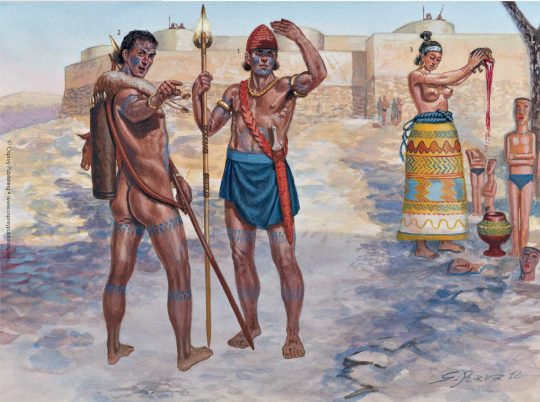

Artwork by Giuseppe Rava from Early Aegean Warrior 5000-1450 BC (Osprey Publishing). Image descriptions from the book below.
EARLY CONTINENTAL AEGEAN SIEGE WARFARE, SESKLO, ABOUT 4400 BC
The scene represents the hypothetical incursion of raiders against the fortified Neolithic settlement of Sesklo. Note the house reconstruction based upon the work of the archaeologist in the Volos Museum.
The ‘Pelasgian’ citadel leader is brandishing a copper axe and wears a splendid example of a copper dagger inserted in leather and copper belt. Jewellery, such as earrings, necklaces and bracelets, was commonly worn as a status symbol by both genders during this period. On the leader’s head is a primitive form of pilos cap, fitted with horns similar to those discovered in a steatite statuette of the period, probably reflecting the worship of the bull and the sacral character of the leader.
The body of this hunter-warrior is covered in tattoos in red minium, similar to those on the acrolithic statuettes of Dimini. Note the obsidian arrowheads and the primitive shape of the bow, reconstructed according to archaeological findings and graffiti. His simple but effective hide clothing was probably very common in Neolithic settlements in the Aegean region.
This man represents one of the elite warriors of the citadel who formed the bodyguard of the leader. His spear and the hypothetical reconstruction of his square shield (some scholars draw comparison with those of Middle East Sumerian culture) indicate the possibility of fighting in a pre-phalanx formation.
CYCLADIC SETTLEMENT AND FORTRESS IN KASTRI-CHALANDRIANI, SYROS, ABOUT 2300 BC
The warrior is copied from a statuette from Syros. He wears a prototype Greek pilos, made from organic material. The spear, from Amorgos, has its point attached to the shaft by means of holes in the blade. Note the dagger from the same locality, worn inside a typical baldric in red leather, decorated in a herringbone pattern.
The design of circular and geometrical tattoos on the body of this hunter can be seen on the remains of a number of statuettes. The early bow, wood reinforced with goat’s horn and sinews, is copied from a specimen represented on a mosaic from Knossos. In Cycladic graves a connection is noticeable between weapons and bone tubes, which often contained blue azurite pigments (in the Manika cemetery these are predominantly associated with female skeletons). The kind of female garment seen here worn by
this priestess, in the colours of the Dama of Phylakopi and in the tradition of coloured Aegean clothes, bears close similarity with Sumerian and Mesopotamian costumes and is also represented on an early Minoan ivory cylinder from Knossos, dated around 2100 BC. Note her rich jewels, taken from specimens from Mochlos and Archanés.
CENTRO-EUROPEAN MIGRATION ON THE PRESENT-DAY GREEK MAINLAND ABOUT 2000-1800 BC
The plate sets out to show a group of those Indo-European peoples who migrated into Greece around 2000–1800 BC, probably from the Balkans and Central Europe.
The warriors in the foreground wear early forms of boar’s tusk helmet copied from the Mariupol and Kolonna specimens. This very primitive boar’s tusk helmet shows that this style of reinforcement and decoration was probably introduced to the Aegean world by the Indo-Europeans migrating from central and north European regions around 2000–1800 BC. Their weapons and jewellery are copied from various finds in central Greece, such as the bronze spearhead from Thiva (Thebes).
The ‘proto-Greek’ Mynian woman is copied from a pottery idol from Euboea. Note the early Aegean style of her garments, borrowed from Crete and the islands.
The early form of chariot is copied from a Late Neolithic pottery model dated 1700 BC from central Europe (Slovakia). The use of the chariot was most likely spread to the Greek mainland from the Near East after the Middle Bronze Age (about 1950–1550 BC) as a result of the central and eastern European migration and the Achaeans’ trade contacts with those regions, although the early attestation of its use in war comes from the Mycenaean Graves A stele.
111 notes
·
View notes
Text
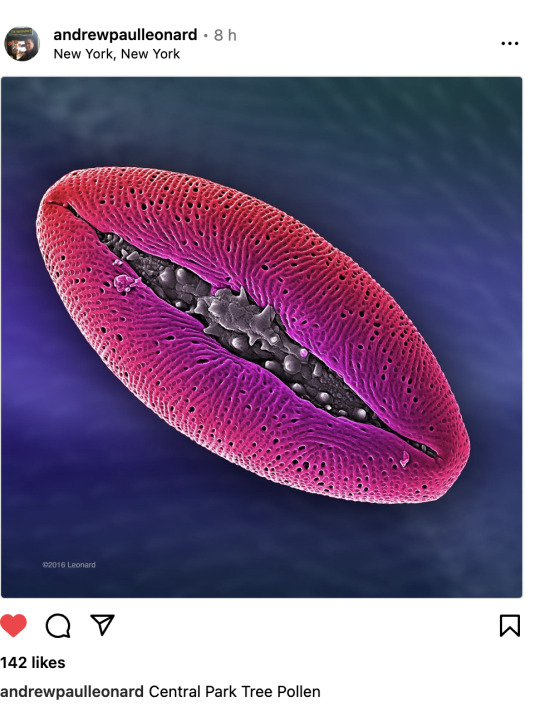
Kiss Kiss! This is what some pollen grains look like under the scanning electron microscope. The exact species wasn't listed in the original post but many plants, ranging from lilies to redbuds, that have pollen grains that look similar to this.
From Wikipedia:
Pollen is a powdery substance produced by flowers of seed plants. It consists of pollen grains (highly reduced microgametophytes), which produce male gametes (sperm cells). Pollen grains have a hard coat made of sporopollenin that protects the gametophytes during the process of their movement from the stamens to the pistil of flowering plants, or from the male cone to the female cone of gymnosperms. If pollen lands on a compatible pistil or female cone, it germinates, producing a pollen tube that transfers the sperm to the ovule containing the female gametophyte. Individual pollen grains are small enough to require magnification to see detail. The study of pollen is called palynology and is highly useful in paleoecology, paleontology, archaeology, and forensics. Pollen in plants is used for transferring haploid male genetic material from the anther of a single flower to the stigma of another in cross-pollination. In a case of self-pollination, this process takes place from the anther of a flower to the stigma of the same flower.
Source: Andrew Paul Lenonard's Instagram page
#katia plant scientist#botany#plant biology#plant science#plants#naturecore#nature#nature photography#microscope#electron microscope#tiny things#pollen#reproduction#mad science#science#biology#flowers#pink lips#juicy lips#luscious lips#beautiful lips#lipstick#kiss kiss
12 notes
·
View notes
Text

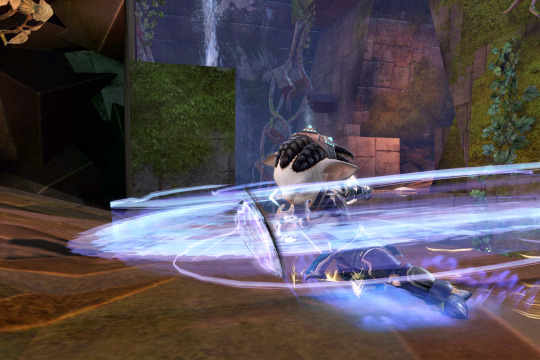


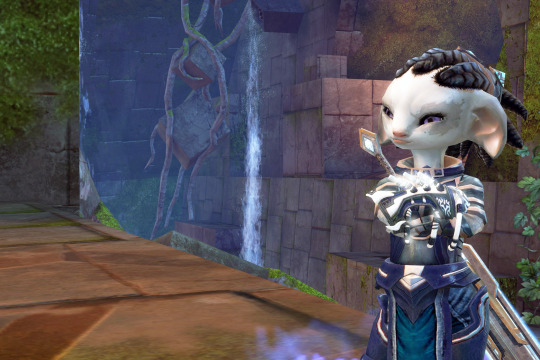
Xeonna the Lost, Asura Firebrand
A relic frozen in time, in the last moments of the last to fall in the lost asuran city of Rata Novus, Xeonna found herself knocked into a specimen containment tube, and the next thing she remembered was waking up to her home as an archaeological ruin, 150 years from anyone she ever knew or loved.
Struggling to adapt in a modern world, she left the ruins of Rata Novus as soon as she was deemed well enough from the stasis sickness, fitted with a new prosthesis to replace the one that had become unusable during her time in magically induced stasis.
She does her best to help as best she can around this new Tyria, seeking peace and desperate for answers as to why she should have been allowed to survive when everyone she knew and loved has died.
18 notes
·
View notes